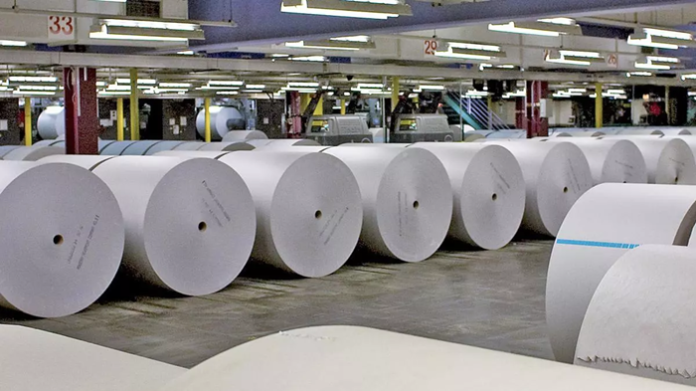
Paper manufacturers in India say the domestic industry is facing a significant crisis due to a surge in paper and paperboard imports, which increased by 34% in FY24, according to government data. The rise in imports, particularly under the free trade agreements (FTAs) with Indonesia and other ASEAN countries, has raised serious concerns among industry stakeholders in India.
Terming it as “dumping,” Pawan Agarwal, president of the Indian Paper Manufacturers Association (IPMA), pointed out that the quality of paper imported into India is far inferior to the standards maintained by the exporting countries themselves. “Dumping should not be allowed and should be monitored. The 34% increase in imports in one quarter is tremendous and may kill the domestic industry.”
The import of major paper grades — uncoated writing and printing paper, coated paper, and paperboard – is rising at an alarming rate, Agarwal says. This surge comes despite substantial investments by the domestic industry in recent years to upgrade technology, improve product quality, and enhance agro/farm forestry practices. These investments are now at risk due to the influx of duty-free imports, he says. The IPMA urged the government to increase the basic customs duty on the import of paper and paperboard from 10 to 25% (the WTO-bound rate for India is 40%).
Challenges for the domestic paper industry
Addressing the core issues, Agarwal highlighted several critical bottlenecks that he says affect the growth of domestic paper manufacturing. These challenges include geographical constraints, limited availability of virgin fiber, and insufficient government support. One of the primary raw materials for the industry — wheat straw — is highly seasonal. Its supply is divided between the paper industry and cattle feed requirements. Additionally, the availability of raw materials from the wood industry is almost negligible.

Agarwal called for government intervention to mitigate these challenges. He urged the government to allocate degraded land for forestry, which could be used to cultivate raw materials for the paper industry. This move, according to Agarwal, would not only benefit the farmers but also positively impact the environment and the entire ecological chain.
“Growing conventional crops does not increase the income of farmers appreciably. But this can be an alternative for the farmers, although it has limitations as the harvesting can only happen after three to four years. So the government should implement some kind of cycle that would be beneficial for the entire chain.”
Economic impact of raw material shortage
Rohit Pandit, secretary general of IPMA, acknowledged the economic impact of the shortage of raw materials on the industry. He said raw materials constitute 40-50% of the total production cost. India, being a raw material-deficit country, finds it commercially unviable to compete with nations with abundant supplies. The increase in imports, coupled with the lack of support for the domestic industry, is making it difficult to sustain, he said.
Agarwal called on the government to renegotiate the terms and conditions of the existing FTAs. He argues that the current agreements fail to protect the interests of the domestic paper industry. The zero-duty imports not only harm the industry’s economic viability but threaten its sustainability and future growth. “We should be careful. The terms and conditions should be revised before signing any FTAs with any country. We can make other agreements to protect the interests of both sides.”
Need for government intervention
Agarwal said despite India’s sufficient domestic capacity to produce nearly all grades of paper, the indiscriminate imports are undermining the commercial viability of many local paper mills. Government data says that out of over 900 paper mills in India, only 553 are currently operational, a clear indication of the adverse impact of these imports.
He highlighted the efforts made by the domestic paper industry in terms of technological advancements. The industry, he says, has been actively investing in new technologies and innovations to enhance its competitiveness on the global stage. However, without adequate government support and a fair trade environment, these efforts may not be sufficient to counter the adverse effects of non-monitored imports, he warned.
The IPMA‘s call for government intervention is rooted in the need to create a supportive ecosystem for the domestic paper industry. Allocating degraded land for forestry, providing financial incentives, and renegotiating FTA terms are some of the measures that could help level the playing field. Such initiatives would ensure the availability of raw materials, reduce production costs, and enhance the industry’s global competitiveness. “The government should understand the importance of the industry as we are a very important cog in the overall wheel of economic development of the country,” Agarwal said.
Paper as a packaging material
Agarwal emphasized the role of the paper industry in providing sustainable alternatives to single-use plastics, particularly in paper packaging. He said the paper industry has the potential to offer eco-friendly solutions, making it a key player in environmental conservation efforts and called for government support.
“The Clean India mission is not possible without the paper industry,” Agarwal said, pointing out that the government’s efforts to ban single-use plastics and address the associated litter and environmental issues can only succeed with the adoption of paper products. By investing in and promoting the use of paper-based packaging, India can make significant growth towards a cleaner, more sustainable future, he said.

















